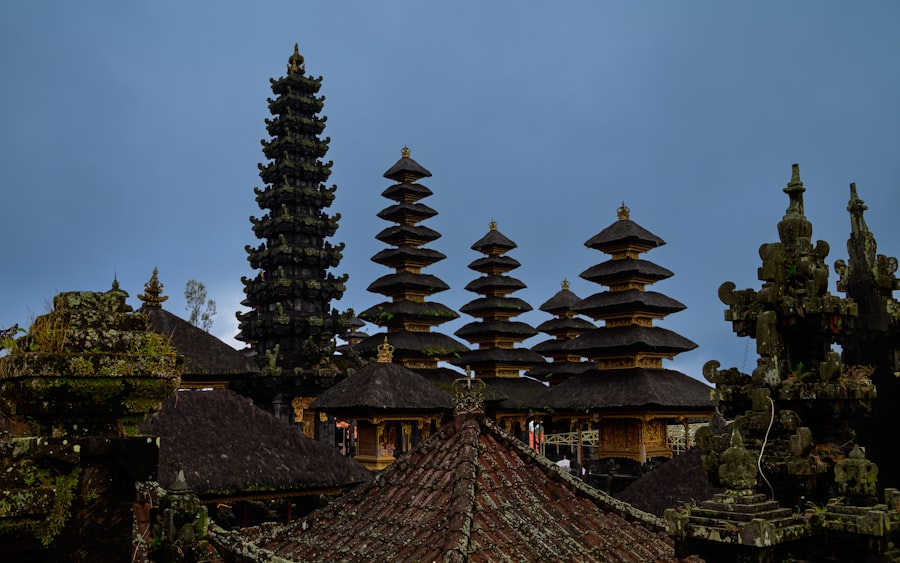Banaue Rice Terraces: The Eighth Wonder of the World
Description
The Banaue Rice Terraces, often referred to as the “Eighth Wonder of the World,” boast a rich history that dates back over 2,000 years. These terraces were carved into the mountains of Ifugao province in the Philippines by the indigenous Ifugao people, who developed sophisticated agricultural techniques to cultivate rice in a challenging mountainous environment. The construction of these terraces is believed to have begun around 2000 B.C., although some estimates suggest that the actual origins may be even older.
The terraces are not merely agricultural fields; they represent a deep connection between the Ifugao people and their land, showcasing their ingenuity and resilience in adapting to their environment. The historical significance of the Banaue Rice Terraces extends beyond their age; they are a testament to the cultural identity and heritage of the Ifugao people. The terraces were built using traditional methods, relying on hand tools and local materials, which reflects a sustainable approach to agriculture that has been passed down through generations.
The terraces are intricately linked to the Ifugao’s spiritual beliefs and practices, with rituals and ceremonies often centered around rice cultivation. This historical context is crucial for understanding the terraces not just as agricultural structures but as living symbols of a culture that has thrived in harmony with nature for millennia.
Key Takeaways
- The Banaue Rice Terraces were built over 2,000 years ago by the Ifugao people, making them a UNESCO World Heritage site and a testament to ancient engineering and agricultural techniques.
- The terraces hold great cultural significance for the Ifugao people, representing their connection to the land, their ancestors, and their sustainable way of life.
- The engineering behind the terraces is a marvel, as they were built without the use of modern tools and machinery, and have withstood natural disasters and the test of time.
- Preservation efforts for the terraces include community-led initiatives, government support, and sustainable tourism practices to protect the integrity of the site.
- The terraces offer breathtaking views of the mountains, valleys, and rice paddies, attracting tourists from around the world and providing economic opportunities for the local communities.
The Cultural Significance of the Banaue Rice Terraces
The cultural significance of the Banaue Rice Terraces is profound, as they embody the traditions, beliefs, and social structures of the Ifugao people. Rice is not merely a staple food; it holds immense cultural value, symbolizing life, prosperity, and community. The terraces are often seen as a manifestation of the Ifugao’s relationship with their ancestors and the land.
Rituals associated with rice planting and harvesting are integral to their cultural practices, reinforcing communal bonds and ensuring the continuity of their agricultural heritage. Moreover, the terraces serve as a canvas for Ifugao artistry and craftsmanship. The intricate designs and patterns of the terraces reflect not only agricultural efficiency but also aesthetic sensibilities that have been honed over centuries.
Festivals celebrating rice harvests are vibrant events that showcase traditional music, dance, and attire, further emphasizing the terraces’ role in cultural expression. These events attract both locals and visitors, fostering a sense of pride among the Ifugao people while also educating outsiders about their rich heritage.
The Engineering Marvel of the Banaue Rice Terraces

The engineering prowess demonstrated in the construction of the Banaue Rice Terraces is nothing short of remarkable. Spanning approximately 2,000 square kilometers, these terraces are an intricate network of rice paddies that ascend steep mountainsides, showcasing advanced agricultural techniques that have been refined over generations. The terraces utilize a system of irrigation that channels water from nearby rivers and streams, ensuring that each level receives adequate moisture for rice cultivation.
This ingenious method not only maximizes agricultural output but also minimizes soil erosion, demonstrating a deep understanding of environmental management. The construction techniques employed by the Ifugao people are equally impressive. The terraces were built using locally sourced stones and earth, with careful attention to drainage and water management.
Each terrace is supported by stone walls that have been meticulously crafted to withstand the test of time. The engineering involved in creating these terraces reflects a sophisticated understanding of topography and hydrology, allowing for sustainable farming practices in an otherwise challenging landscape. This mastery of engineering has earned the Banaue Rice Terraces recognition as a UNESCO World Heritage Site, highlighting their significance not only as agricultural structures but also as cultural landmarks.
The Preservation Efforts for the Banaue Rice Terraces
| Preservation Efforts for the Banaue Rice Terraces | ||
|---|---|---|
| Year | Preservation Effort | Impact |
| 1995 | UNESCO World Heritage Site designation | Increased international recognition and protection |
| 2007 | Banaue Rice Terraces Restoration Project | Rehabilitation of damaged terraces and irrigation systems |
| 2015 | Community-based conservation initiatives | Empowerment of local communities in preservation efforts |
Preserving the Banaue Rice Terraces has become increasingly important in light of modern challenges such as climate change, urbanization, and changing agricultural practices. Various organizations, including local government units and non-governmental organizations (NGOs), have initiated preservation efforts aimed at safeguarding this cultural heritage site. These initiatives often focus on promoting sustainable farming practices among local communities while also raising awareness about the importance of maintaining traditional agricultural methods.
One notable effort is the establishment of community-based programs that encourage younger generations to engage in rice farming and terrace maintenance. By providing training and resources, these programs aim to instill a sense of pride in traditional practices while ensuring that knowledge is passed down through generations. Additionally, eco-tourism initiatives have been developed to promote responsible tourism that benefits local communities while minimizing environmental impact.
The Breathtaking Views of the Banaue Rice Terraces
The visual splendor of the Banaue Rice Terraces is one of their most captivating features. As visitors approach the terraces, they are greeted by a stunning panorama of verdant green fields cascading down steep mountainsides, creating a breathtaking tapestry that changes with the seasons. During planting season, the terraces glisten with water reflecting the sky, while harvest time transforms them into golden waves of ripe rice ready for collection.
This dynamic landscape not only captivates photographers and nature lovers but also serves as a reminder of the harmony between human ingenuity and natural beauty. The views from various vantage points around Banaue offer unique perspectives on this agricultural marvel. Popular lookout spots provide sweeping vistas that allow visitors to appreciate the scale and intricacy of the terraces.
Sunrise and sunset create particularly magical moments when the soft light bathes the landscape in warm hues, enhancing its ethereal quality. These breathtaking views have made Banaue a sought-after destination for travelers seeking both adventure and tranquility amidst nature’s grandeur.
The Impact of Tourism on the Banaue Rice Terraces

Economic Benefits and New Opportunities
The increased tourist interest has led to economic benefits for local communities, creating jobs in hospitality, guiding services, and local crafts.
Challenges and Threats to the Terraces
However, tourism also poses challenges that threaten the integrity of the terraces. The influx of visitors can lead to environmental degradation if not managed properly, resulting in issues such as littering, soil erosion, and water pollution from unregulated tourist activities. Furthermore, there is concern about cultural commodification, where traditional practices may be altered or diluted to cater to tourist expectations.
Striking a Balance for Sustainability
Balancing economic benefits with sustainable practices is crucial for ensuring that tourism does not compromise the very essence of what makes the Banaue Rice Terraces so special. It is essential to find a balance that preserves the cultural and environmental integrity of this unique site while still allowing local communities to benefit from tourism.
The Indigenous Communities of the Banaue Rice Terraces
The indigenous communities surrounding the Banaue Rice Terraces are integral to understanding their significance and history. The Ifugao people have lived in this region for centuries, developing a rich cultural tapestry woven from their agricultural practices, spiritual beliefs, and social structures. Their deep connection to the land is evident in their customs and traditions, which revolve around rice cultivation and communal living.
The Ifugao’s unique social organization includes kinship ties that strengthen community bonds and facilitate cooperation in farming activities. These communities are custodians of traditional knowledge that has been passed down through generations. Elders play a vital role in preserving cultural practices related to rice farming, including rituals that honor ancestral spirits believed to protect crops.
As modern influences encroach upon their way of life, there is a growing movement among younger Ifugao individuals to reclaim and revitalize their cultural heritage. This resurgence is evident in efforts to promote traditional music, dance, and crafts while also advocating for land rights and sustainable agricultural practices.
The Future of the Banaue Rice Terraces
The future of the Banaue Rice Terraces hinges on a delicate balance between preservation and adaptation in an ever-changing world. As climate change continues to impact agricultural practices globally, local farmers face new challenges such as unpredictable weather patterns and shifting pest populations. To combat these issues, innovative approaches are being explored that integrate traditional knowledge with modern agricultural techniques.
This fusion aims to enhance resilience while maintaining cultural integrity. Furthermore, ongoing efforts to promote sustainable tourism can play a pivotal role in securing the future of these terraces. By fostering responsible travel practices that respect local customs and minimize environmental impact, visitors can contribute positively to the preservation of this cultural landscape.
Education initiatives aimed at both tourists and locals can raise awareness about the importance of protecting this heritage site for future generations. Ultimately, ensuring that the Banaue Rice Terraces continue to thrive will require collaboration among indigenous communities, government agencies, NGOs, and tourists alike—each playing a part in safeguarding this extraordinary testament to human ingenuity and cultural heritage.
If you are interested in learning more about the Banaue Rice Terraces, you may want to check out this article on YouTube 2. This article may provide additional insights or information about the famous terraces and their significance.
FAQs
What are the Banaue Rice Terraces?
The Banaue Rice Terraces are ancient terraces carved into the mountains of Ifugao in the Philippines. They are often referred to as the “Eighth Wonder of the World” and are a UNESCO World Heritage Site.
How were the Banaue Rice Terraces created?
The terraces were hand-carved over 2,000 years ago by the ancestors of the indigenous Ifugao people using minimal equipment. They were created to make the mountainous terrain suitable for rice cultivation.
What is the significance of the Banaue Rice Terraces?
The terraces are not only a stunning example of ancient engineering and agricultural practices, but they also hold cultural and spiritual significance for the Ifugao people. They are a symbol of their connection to the land and their ancestors.
How big are the Banaue Rice Terraces?
The terraces cover approximately 10,360 square kilometers of mountainside and are estimated to stretch about 20,000 kilometers if laid end to end.
Can visitors explore the Banaue Rice Terraces?
Yes, visitors are welcome to explore the terraces and the surrounding villages. There are hiking trails and guided tours available for those who want to experience the beauty and history of the area.





